Bulletin – December 2014 Global Economy Chinese Rebalancing and Australian Exports
- Download the article 1.89MB
Abstract
The Chinese authorities plan to gradually rebalance the composition of Chinese economic growth from investment towards household consumption. This article uses the World Input-Output Database (WIOD) to give a general sense of how this rebalancing might affect Australian exports and economic activity. Dollar for dollar, Chinese investment appears to absorb more than twice as much Australian value-added output as Chinese household consumption. This largely reflects the significant role of resource commodities in Australia's exports to China, which are used more intensively in investment than consumption. Simple analysis using the WIOD suggests that a shift from investment to consumption in China is likely to weigh on the growth of demand for Australia's mineral resources, although a rise in demand by Chinese households for food products and services could provide some offset.
Introduction
Since the early 2000s, Chinese economic growth has been supported by rapid growth of investment. Accordingly, the investment share of GDP has risen from 36 per cent to 46 per cent over the past 10 years or so (Graph 1). The Chinese authorities have emphasised that the investment share cannot sustainably remain at its recent levels, and that household consumption should become increasingly important as a driver of growth as the economy develops (see, for example, NPC (2011)). Indeed, in recent years household consumption's share of GDP has trended a little higher, suggesting that the process of rebalancing may already have begun. As the Chinese economy continues to move towards more consumption-driven growth, the balance of activity across the different sectors of the economy can be expected to change. In particular, the tertiary (services) sector's share of the economy is likely to increase further and the secondary (manufacturing and construction) sector's share is likely to decline, as has happened in other economies as they developed.[1]

Australian exports to China consist primarily of resources, particularly iron ore and coal, and China's manufacturing sector (especially steel production) absorbs the majority of these exports. This sector, in turn, relies to a significant extent on investment, and particularly construction-related investment, as a driver of demand. A shift in the composition of Chinese growth therefore has important implications for Australia's economic links with China. The World Input-Output Database (WIOD) can provide a sense of how Chinese household consumption might differ from Chinese investment in terms of demand for Australian exports. These data measure domestic and international flows of goods and services of 35 industries in 41 regions for the years 1995 to 2011.[2] Each ‘table’ represents a snapshot of the structure of the world economy for the year in question, measuring how the output of each industry in each country flows either to intermediate uses (i.e. as inputs into production) or final uses (as consumption or investment).[3]
For a given amount of final demand in China, the WIOD allows us to estimate how much of this demand will ultimately be met by Australian value-added output.[4] Standard techniques can then be applied to determine how much demand for Australian value-added output comes from Chinese investment and how much comes from Chinese consumption.[5] The analysis relates only to the composition of economic activity in China rather than the growth of the Chinese economy. As such, it gives an impression of how the variation in the balance between household consumption and investment in China could affect the Australian economy.
One important caveat to this analysis is that it does not consider any possible change in demand for Australia's exports by other trading partners, or any change in industry production activities within Australia in response to changing global demand or supply. Moreover, input-output analysis is subject to some notable data limitations. First, the flows in the WIOD's input-output tables represent values rather than volumes, so that the changes over time may represent either price or quantity effects. It might be reasonable to expect large quantity effects driven by changes in demand to be reinforced by price effects, which would reduce the accuracy of estimates.[6] Second, the WIOD's input-output tables are released after a considerable time lag, with the most recent tables (for 2011) describing economic relationships that are likely to have since changed somewhat. Nonetheless, the WIOD provides a means of deriving rough estimates of some of the potential effects of Chinese rebalancing on Australian exports and economic activity.
Sectoral Composition of Chinese Final Demand Components
According to the WIOD, household consumption accounted for 36 per cent of Chinese final expenditure in 2011, and investment accounted for 46 per cent.[7] Chinese household final consumption expenditure largely consisted of spending on services and food (Graph 2). Construction accounted for more than half of Chinese investment, with electrical, optical & transport equipment and other machinery accounting for another 16 per cent and 12 per cent, respectively. These differences in the nature of expenditures, and the variation in different Chinese sectors' demand for Australian exports, can be used to give a sense of how a rebalancing of activity from investment to household consumption might affect the Australian economy.
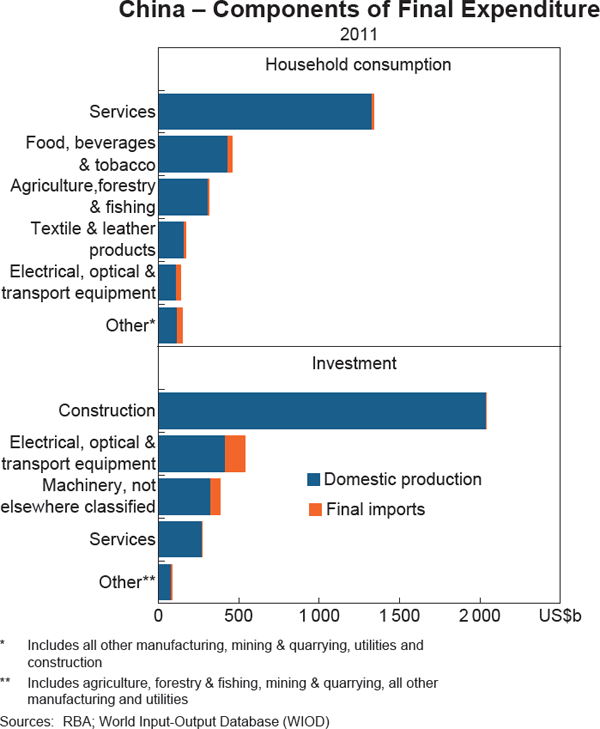
China's imports from Australia are primarily intermediate goods. Unlike final imports, these intermediate imports do not go directly to either household consumption or investment, but are instead used to produce other goods or services. In 2011, around 80 per cent of China's total imports were intermediate goods and services, of which 7 per cent were from Australia (Graph 3).[8] These accounted for 95 per cent of total Australian exports to China. In contrast, Australian exports of final goods and services represented only a small fraction of China's total final imports, which themselves account for only a small share of Chinese final expenditure.
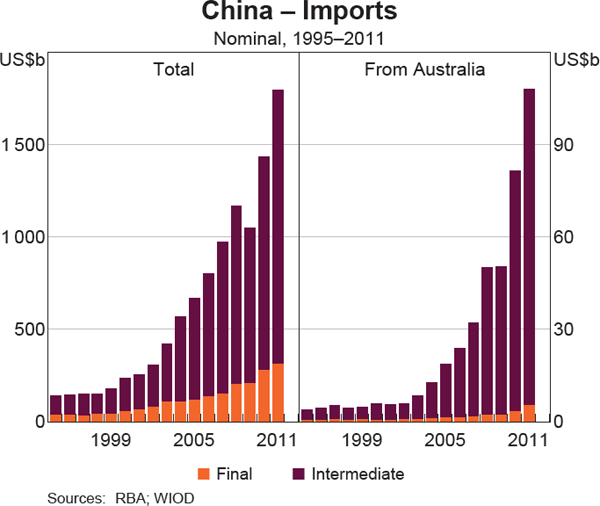
In 2011, the basic metals & fabricated metal industry underpinned the bulk of Chinese demand for Australian intermediate exports (Graph 4).[9] This industry directly accounted for one-quarter of the total output of Australia's mining industry in 2011, and more than 60 per cent of all Australian exports to China. Around 90 per cent of the output from the basic metals & fabricated metal industry went towards domestic intermediate use, providing important inputs into other Chinese industries producing goods and services both for export and for domestic use.
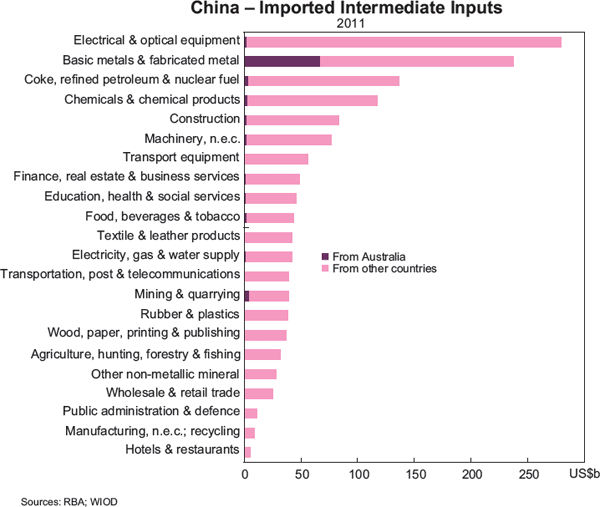
According to the WIOD, investment accounts for more than half of the demand for Chinese metals manufacturing production, and the construction sector accounts for about two-thirds of this demand (Graph 5).[10] In addition, the WIOD suggests that almost one-third of the output of Chinese metals manufacturing is ultimately attributable to foreign demand for Chinese output, mainly embodied in the exports of other industries that use manufactured metals products as inputs (similar to the findings of Roberts and Rush (2010)). Household consumption in China accounts for less than 10 per cent of the demand for metals manufacturing production. The importance of investment demand for the output of the Chinese metals manufacturing sector suggests a similar importance (relative to household consumption) for the Australian economy, due to the specialised nature of Australian exports to China.
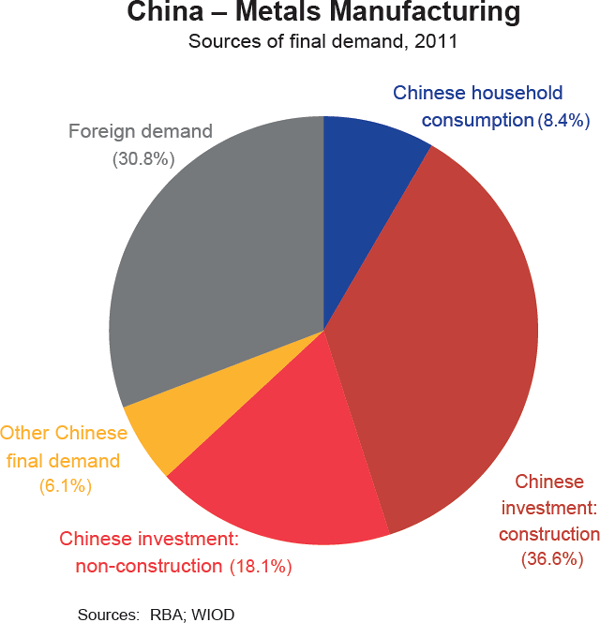
The Contribution of Australian Value-added Output to Chinese Final Demand
To estimate the effect of Chinese rebalancing on Australian exports, it is necessary to draw a distinction between Australia's gross exports and ‘value-added exports’ to China. Gross exports are simply the total value of goods and services exported from Australia to China. Value-added exports are calculated by removing from gross exports the value of (a) the content that is re-exported in some form from China to other countries, and (b) the contribution to Australian exports to China made by imports from outside Australia (e.g. the cost of imported machinery used in Australia's mining industry to produce resource exports).[11] These calculations suggest that total Australian value-added exports to China were approximately 70 per cent of gross exports to China in 2011 (Graph 6). These value-added exports to China accounted for about 5 per cent of Australia's total value-added output and 27 per cent of the value-added output of the mining industry.
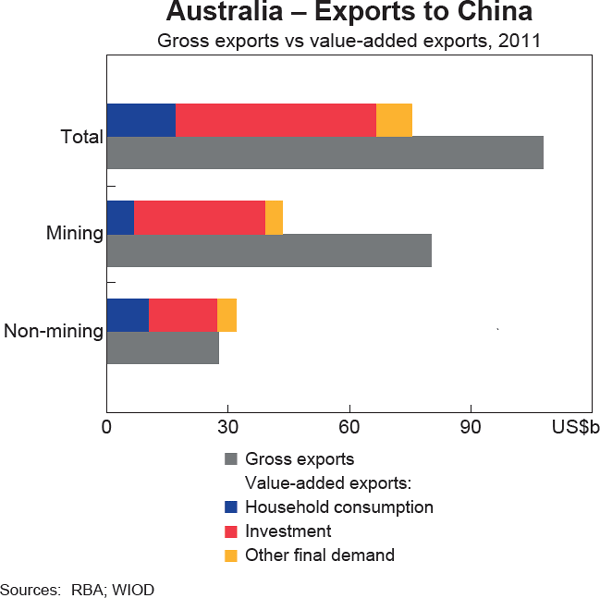
The value-added exports of Australia's mining sector were lower than its gross exports, while the value-added exports of the non-mining sector exceeded its gross exports. This largely reflects the contribution made by non-mining sectors in providing inputs into Australia's mining sector, such as mining-related business services. Hence, much of the value added in Australia's exports of mineral resources can be attributed to the non-mining sector. This effect also contributes to the importance of the role that Chinese investment plays in the value-added exports of Australia's non-mining sector.[12]
Chinese investment accounts for the largest share of Australian value-added exports both because it is the largest share of Chinese final demand and because it is weighted toward Chinese industries with more intensive requirements for Australian value-added output. The Chinese construction industry had by far the highest total requirements for Australian value-added output in 2011, accounting for almost half of the total (Table 1). Australian value-added output was also relatively significant for a range of manufacturing industries important for investment, including machinery, transportation equipment, and electrical & optical equipment. In addition to requiring significant Australian content in absolute terms, these industries also had relatively high requirements for Australian value-added exports per dollar of output, suggesting that rebalancing of activity away from these industries would be likely to weigh on Chinese demand for Australian value-added output. In contrast, food, beverage and tobacco manufacturing have high requirements in absolute terms but fairly low requirements per dollar of Chinese demand. Similarly the agriculture industry and most of the tertiary sector – which are more important for household consumption – had relatively low per dollar Australian content requirements.
| Sector | Share of australian value-added exports to China Per cent | Required australian value-added output per $1 of Chinese demand $ |
|---|---|---|
| Construction | 46.7 | 0.016 |
| Services | 17.1 | 0.005 |
| Machinery, not elsewhere classified | 9.9 | 0.020 |
| Transport equipment | 6.7 | 0.015 |
| Electrical & optical equipment | 6.3 | 0.016 |
| Basic metals & fabricated metals | 4.0 | 0.051 |
| Food, beverages & tobacco | 3.9 | 0.006 |
| Other(a) | 5.4 | 0.005 |
| Total | 100.0 | 0.011 |
|
(a) Includes agriculture, forestry & fishing, mining & quarrying, utilities and all other manufacturing Sources: RBA; WIOD |
||
The estimates indicate that in 2011, each dollar of Chinese investment involved more than double the demand for Australian value-added output compared with each dollar of household consumption, and almost four times the demand for the Australian mining sector's value-added output (Table 2; Graph 7). Assuming no changes in prices, or any change in production patterns in Australia or elsewhere, this suggests that a shift of $1 from Chinese investment to Chinese household consumption would by itself reduce demand for Australian value-added output by about 0.8 cents, of which 0.7 cents would be from the Australian mining industry. To put this in some perspective, if in 2011 China's consumption share of GDP had been 10 percentage points higher and the investment share 10 percentage points lower, the estimates suggest this could have lowered Australian GDP by about ½ per cent. In practice, however, such a marked shift in the composition of China's growth could only be expected to happen over a number of years; over such a time period, relative prices, including the exchange rate, as well as demand for the goods and services that Australia produces, could change significantly both in China and elsewhere. In other words, rebalancing in China could be expected to have some dampening effect on growth in Australia, but the extent of this effect is highly uncertain.
| $1 of Chinese household consumption | $1 of Chinese investment | |
|---|---|---|
| Total Australian value added | 0.0067 | 0.0149 |
| Australian mining value added | 0.0026 | 0.0098 |
| Australian non-mining value added | 0.0041 | 0.0051 |
|
Sources: RBA; WIOD |
||
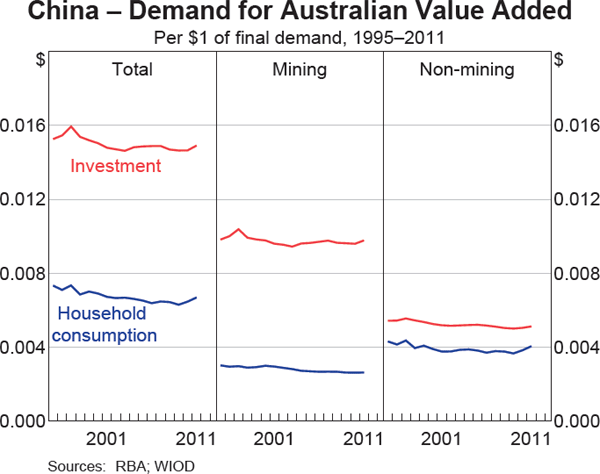
Conclusion
Slowing Chinese investment growth accompanied by a rise in the growth of household consumption is likely to weigh somewhat on demand for Australian minerals, and could reduce the overall growth of Australian value-added exports to China. However, there are many uncertainties about how this would play out in practice, which makes it difficult to judge the implications for overall economic activity in Australia. While growth in Chinese demand is expected to slow from the rapid rates seen over the past decade, this growth will be from a much higher base, and the overall volume of Chinese imports is likely to expand further. Chinese rebalancing is likely to be a gradual process, which means that the Australian economy should have some time to adapt. Australian producers may well find alternative markets for their products, or the composition of production may alter in response to changing global demand and supply conditions (and any resulting changes in the Australian terms of trade). For example, a more developed Chinese economy with a higher consumption share is likely to involve greater demand by households for items such as food, education and tourism, which will provide opportunities for firms outside the Australian resources sector. These factors should see the Chinese economy continue to be an important source of demand for Australian goods and services in coming decades.
Footnotes
The author is from Economic Group. [*]
For an analysis of trends in China's household consumption and related policies, see Baker and Orsmond (2010). For a general overview of the relationship between economic development and the reallocation of economic activity across sectors, see Herrendorf, Rogerson and Valentiny (2014). [1]
For an overview of the WIOD's contents, sources and methods, see WIOD website at <http://www.wiod.org> and Timmer (2012). For more details on how the WIOD can be used to complement Australian trade statistics, see Kelly and La Cava (2014). [2]
Investment is split into changes to inventories (inventory investment) and gross fixed capital formation (GFCF). Inventory investment generally accounts for only a very small share of output, and this article considers the GFCF or non-inventory component of investment only. [3]
Value-added output refers to the difference between the value of gross output and the value of intermediate inputs, and corresponds to the value contributed by labour and capital. The WIOD data only measure value added in total and do not distinguish compensation of employees (wages) from gross operating surplus (profits). In this context, gross operating surplus refers to the return on capital involved in Australian production regardless of whether or not the capital is domestically owned. [4]
The flows of intermediate inputs between industries yield a 1435 × 1435 matrix of technical requirements. Calculating the ‘Leontief inverse’ (the infinite geometric series of this matrix) allows any element of final demand to be related to the total gross output necessary to produce that element as well as its required intermediate inputs – and these inputs' required intermediate inputs – through every stage of production. Mathematically, for n sectors, define Z as an n×1 vector of all sectors' gross output, then Z = X + Y where vector X gives intermediate uses and vector Y gives final uses. X = AZ, where A is an n×n matrix of technical requirement coefficients between 0 and 1. Then Z = AZ + Y, or Z = (I − A) −1 Y, where (I − A)−1 is the ‘Leontief inverse’, which can be multiplied by any vector representing elements of final demand to arrive at the necessary output. For further details, see Kelly and La Cava (2014). [5]
Basic input-output analysis also only considers average effects and not marginal effects. [6]
These are similar to the shares of 2013 GDP in China's national accounts data. [7]
China has a trade deficit in intermediate goods and services and a trade surplus in final goods and services. [8]
Note that the sector labels in Graph 4 refer to the sector using the intermediate input, not the category of intermediate input; in the case of China's basic metals & fabricated metal sector, most of the inputs come from Australia's mining & quarrying sector. [9]
The WIOD does not contain enough information to distinguish between the different types of Chinese construction (e.g. housing versus infrastructure) in terms of their metal usage intensity. These questions have been considered in Berkelmans and Wang (2012) and Wilkins and Zurawski (2014). [10]
Value-added exports from Australia to China also adds to gross exports any content from Australia that ultimately arrives in China after being used as intermediate inputs to production in third countries. Similarly, the value-added exports of a particular sector can be estimated by subtracting from the value of its gross exports the contribution made by the intermediate inputs from other sectors, and adding the contribution that it makes to the exports of other sectors. For more detail on the distinction between gross exports and value-added exports, see Kelly and La Cava (2014). [11]
The inter-industry links through which non-mining sectors' value added is embodied in mining exports are analysed using Australian input-output tables in Rayner and Bishop (2013). [12]
References
Baker M and D Orsmond (2010), ‘Household Consumption Trends in China', RBA Bulletin, March, pp 13–17.
Berkelmans L and H Wang (2012), ‘Chinese Urban Residential Construction to 2040’, RBA Research Discussion Paper No 2012-04.
Herrendorf B, R Rogerson and A Valentiny (2014), ‘Growth and Structural Transformation’, in P Aghion and SN Durlauf (eds), Handbook of Economic Growth, Volume 2, Handbooks in Economics, Elsevier, Oxford, pp 855–941.
Kelly G and G La Cava (2014), ‘International Trade Costs, Global Supply Chains and Value-added Trade in Australia’, RBA Research Discussion Paper No 2014-07.
NPC (The National People's Congress of the People's Republic of China) (2011), (Twelfth Five-Year Plan for National Economic and Social Development), 17 March. Available at <http://www.npc.gov.cn/npc/xinwen/2011-03/17/content_1647851.htm>.
Rayner V and J Bishop (2013), ‘Industry Dimensions of the Resource Boom: An Input-Output Analysis’, RBA Research Discussion Paper No 2013-02.
Roberts I and A Rush (2010), ‘Sources of Chinese Demand for Resource Commodities’, RBA Research Discussion Paper No 2010-08.
Timmer MP (ed) (2012), ‘The World Input-Output Database (WIOD): Contents, Sources and Methods’, WOID Working Paper No 10 . Available at <http://www.wiod.org/publications/papers/wiod10.pdf>.
Wilkins K and A Zurawski (2014), ‘Infrastructure Investment in China’, RBA Bulletin, June, pp 27–35.